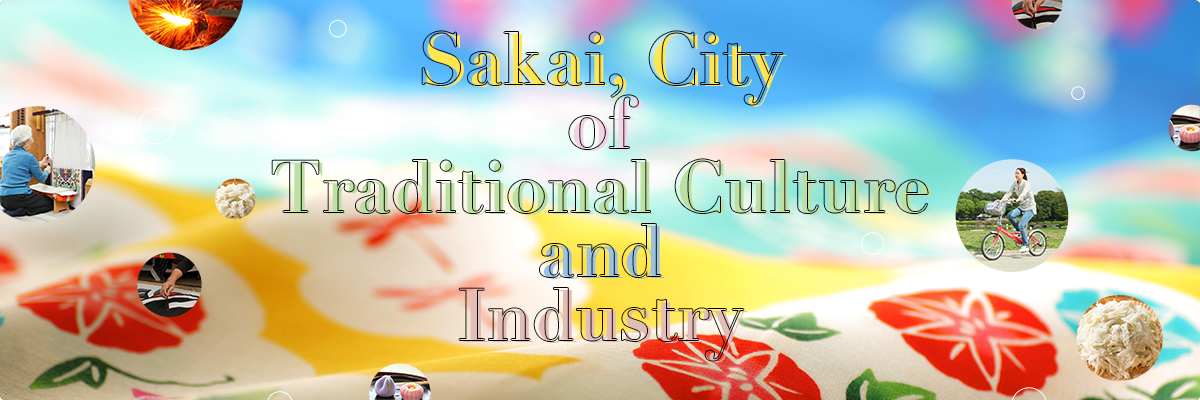Sakai, City of Traditional Culture and Industry

Traditional Industries Nurtured by Sakai's Long History
Sakai was once a city of free trade known as the "Venice of the East," and operated as a base of trade in which people, things, and information from around the world all gathered. This historical background and free-spirited climate served to develop a variety of traditional industries in Sakai. Among them you will find many that also went on spread out into the world after being born here. The follows is an introduction to the truly representative industries of the city.
{{ // BLOCK END }}
Knives
Sakai is a major producer of knives. This history starts long ago, with the development of skilled blacksmiths in order to produce the tools required for tumulus construction. During the middle ages, the name of the region was known across Japan for the production of swords, guns, and tobacco knives. In modern times, Sakai boasts a 90% share of the Japanese knives used by professional chefs. The reason for this is the division of the industry between the blacksmiths capable of making strong yet supple steel and the sharpeners who created the sharpest possible edge, each having honed their craft to the limit. Another appealing point is each and every knife being handmade, meaning the length and thickness can be adjusted on a scale of literally millimeters in accordance with the desires of the one placing the order. The skills of these masters have been registered as UNESCO Intangible Cultural Heritage, and have greatly contributed to the development of Japanese cuisine.
{{ // BLOCK END }}
Senko (Incense Sticks)
Senko are Japanese incense sticks, created by hardening powered fragrant wood, other fragrances, and Chinese medicinal herbs into sticks. Originating in Sakai approximately 400 years ago, they have long been used in Buddhist ceremonies and memorial services. The reasons for their development can be attributed to Sakai being the largest international trading port in Japan at the time, allowing for raw materials to be easily obtained though trading, and it having the most temples behind only Kyoto and Nara. The Sakai senko created using carefully selected materials and the unique perfuming techniques of true craftspeople have even been called "fragrant works of art." They are currently loved for a wide range of purposes, including use in aromatherapy and as aromatics.
{{ // BLOCK END }}
Wazarashi & Yukata
"Wazarashi" is bleached cloth made from cotton, with all the starch and other impurities removed. It was developed during the 17th century along the Ishizugawa River in water-rich Sakai, and the city still boasts a 70% share of the market today. As a result of this, Sakai also developed "Chusen" dyeing technology, used to dye wazarashi material for yukata by hand. The appeal of this technique is that, due to the dye being poured over the material from above, it allows for brilliant colors to appear on both sides of the material, unlike machine printing. The color also doesn't fade even after the clothing has been worn for a long time. This technique is widely used for a variety of purposes today, including making T-shirts and stoles.
{{ // BLOCK END }}
Konbu Seaweed
In the 17th century, the "konbu road" route was opened to transport the konbu seaweed harvested in Hokkaido to Sakai by ship, allowing for the fundamental development of the konbu processing industry in Sakai. During the first half of the 20th century the city flourished as a major producing region. Production was centered around "tororo konbu" and "oboro konbu," involving delicately slicing the konbu. The latter is still handmade today by veteran craftspeople, with the knives used to cut the konbu also made in Sakai. Expert handling of those knives realizes a delicate, melt-in-the-mouth delicacy with a rich flavor.
{{ // BLOCK END }}
Confectionery
Influenced by Sen no Rikyu bringing tea ceremony to prominence in the 16th century, the making of confectionery to serve alongside that tea also developed in Sakai. At the time it was the largest trading city in Japan, with the ease of obtaining important materials such as sugar thought to have given a further push to that development. A variety of confectionery stores can still be found in Sakai today, from the long-standing to the brand new, and they continue to represent the changing of the seasons through beautiful visuals and delicate flavors.
{{ // BLOCK END }}
Dantsu Rugs
"Dantsu" is the Japanese name given to thick handwoven rugs made from wool. They originated from the Middle and Near East, and reached Japan via China. Manufacturing in Sakai started in the 19th century, and export also thrived for a while. They are made by hand weaving a variety of threads together and then trimming using special shears. In modern times, technological innovations and the development of new materials have allowed for the creation of new rug products offering excellent functionality and designs.
{{ // BLOCK END }}
Bicycles
Bicycles arrived in Japan from Europe in the 19th century. In the beginning many were imported, which also meant many malfunctions, and it was the gunsmiths of Sakai with their excellent metalworking abilities who contributed most to the required repairs and manufacturing of parts. Eventually the bicycles started being produced domestically, and the Japanese bicycle industry developed from Sakai. The city still boasts a high share of the markets for completed bicycles and the manufacturing of parts.
{{ // BLOCK END }}